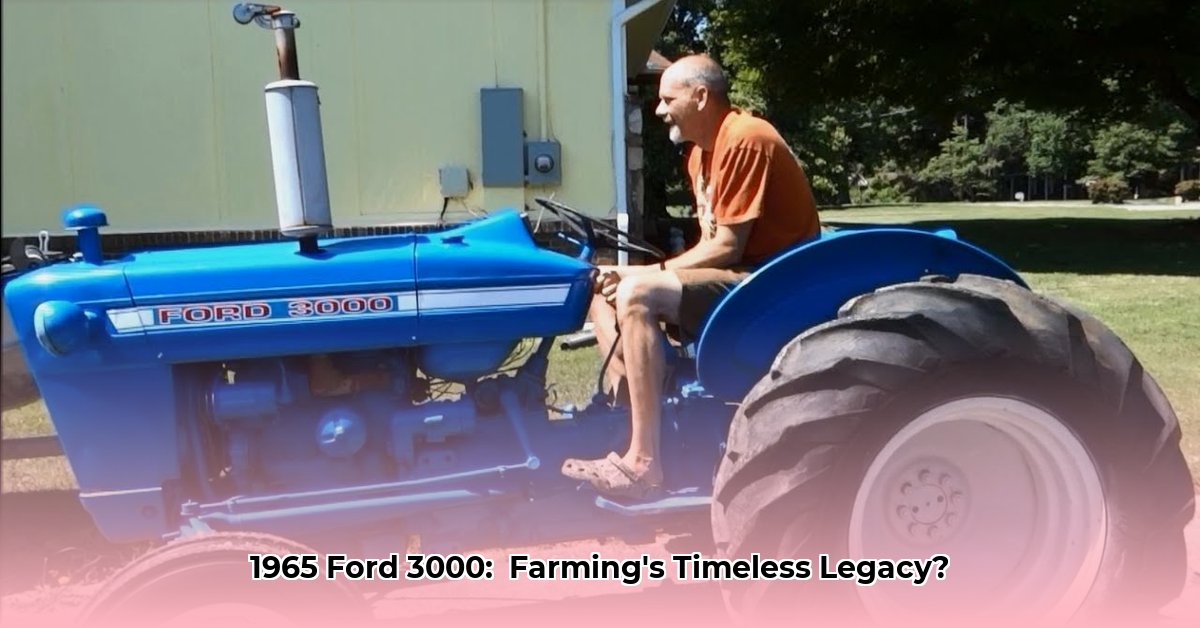
The 1965 Ford 3000 tractor stands as a pivotal artifact in agricultural history, offering a compelling case study in the evolution of sustainable farming practices. Its impact on agricultural efficiency is undeniable, yet its environmental implications require careful scrutiny, especially in light of modern sustainability concerns. This article delves into the Ford 3000's legacy, exploring its historical context, technical specifications, and lasting influence on the ongoing pursuit of environmentally responsible agriculture. For more information on similar Ford tractors, see this Ford 2000 information.
A Workhorse of its Era: The Ford 3000's Impact
In 1965, agricultural practices heavily relied on manual labor and animal power. The Ford 3000, with its robust build and relatively simple mechanics, represented a transformative leap in efficiency. It enabled farmers to accomplish significantly more in less time, boosting productivity and crop yields. However, this increased efficiency came with unforeseen environmental trade-offs.
The tractor's substantial weight (3700 to 4185 pounds) 1, while beneficial for powerful operation, contributed to soil compaction—a significant drawback in contemporary sustainable agriculture. Compacted soil hinders water infiltration, reduces aeration, and negatively impacts overall soil health and long-term crop yields. Furthermore, its 13-gallon fuel tank, while sufficient for its time, pales in comparison to the larger, more fuel-efficient tanks of modern tractors, highlighting a key area of inefficiency. This raises a crucial question: how can we reconcile the Ford 3000's undeniable productivity gains with its potentially detrimental long-term environmental consequences?
Sustainability and the Ford 3000: A Nuanced Perspective
Analyzing the Ford 3000's sustainability requires a nuanced understanding of its historical context. Was it a genuine step forward or an unwitting precursor to some of the environmental challenges we confront today? A comprehensive evaluation necessitates examining several key factors:
1. Fuel Efficiency: How did the Ford 3000's fuel consumption compare to its contemporaries, and how does it stack up against modern tractors? Analyzing its total fuel usage throughout its operational lifespan provides a more complete picture of its fuel efficiency.
2. Soil Compaction: The significant weight of the Ford 3000 undeniably led to soil compaction. Modern sustainable farming practices prioritize minimizing this damage to preserve soil structure and fertility.
3. Lifecycle Analysis: A complete environmental assessment should encompass the entire lifecycle of the tractor. This includes the manufacturing process, the environmental impact of the materials used, its operational lifespan, and ultimately, its disposal.
Technological Advancements and Trade-offs: Progress and its Price
The Ford 3000's influence extended beyond its immediate impact, spurring advancements in agricultural technology. Its increased efficiency undeniably boosted food production. Different transmission options suggested efforts towards optimizing fuel usage for various tasks. However, its limitations remain: its dependence on fossil fuels and the resultant greenhouse gas emissions impose a considerable environmental burden.
Then and Now: A Comparative Analysis
A direct comparison to contemporary and modern tractors provides valuable context for evaluating the Ford 3000's legacy.
| Feature | 1965 Ford 3000 Tractor | Modern Tractor |
|---|---|---|
| Primary Fuel Source | Gasoline/Diesel | Primarily Diesel, Increasing Biodiesel Options |
| Fuel Efficiency | Relatively low | Significantly higher |
| Engine Technology | Simpler, less sophisticated | Advanced, precise engine management systems |
| Emissions | Higher | Significantly lower, stricter emission controls |
| Soil Compaction Potential | High | Reduced through technology (e.g., wider tires) |
| Availability of Sustainable Practices | Limited to minimal | Integrated GPS, precision farming, variable rate tech |
The Ford 3000's Enduring Legacy: Lessons Learned
The 1965 Ford 3000 serves as a potent reminder of the continuous evolution of agricultural technology and the ongoing quest for sustainable practices. Its legacy underscores the need to critically examine historical innovations and strive for constant improvement. By understanding its strengths and weaknesses, we can work towards incorporating its positive aspects while mitigating its negative environmental consequences.
Calculating the Lifecycle Environmental Impact: A Methodological Approach
A thorough assessment of the Ford 3000's environmental impact requires a comprehensive lifecycle analysis. This involves a detailed examination of several key factors:
Manufacturing: The resources and energy consumed during the manufacturing process, including the emissions generated, must be considered. This varied considerably depending on manufacturing location (Belgium, England, or the USA).
Operation: Fuel consumption during the tractor's operational life is a primary contributor to greenhouse gas emissions. Operational efficiency, influenced by factors such as tractor maintenance and operator skill, significantly impacts fuel usage.
Maintenance and Repairs: The materials and energy used in repairs and maintenance throughout the tractor's lifespan contribute to its overall environmental impact. The availability of parts for vintage machinery poses a significant challenge.
End-of-Life: The final disposal or recycling of the tractor also impacts the environment. Appropriate dismantling and responsible recycling are crucial.
Data limitations hinder the precise quantification of the Ford 3000's environmental impact. Further research is needed to address these gaps.
Key Takeaways and Future Research Directions
- The Ford 3000's environmental impact requires a holistic lifecycle assessment.
- Data availability challenges necessitate further research to accurately quantify its footprint.
- Comparative analysis provides crucial insights into the advancements in agricultural technology and their environmental consequences.
- The tractor's legacy highlights the complex interplay between technological progress and its environmental implications.
- Future research should focus on refining lifecycle analysis methods for vintage machinery and exploring the potential for incorporating sustainable practices into the restoration and continued use of such machinery.